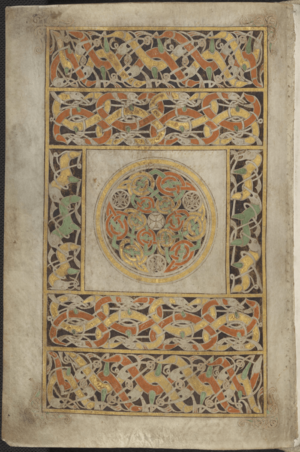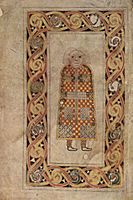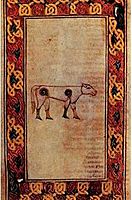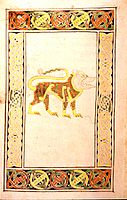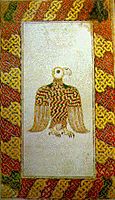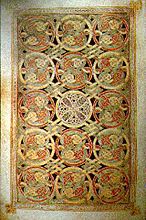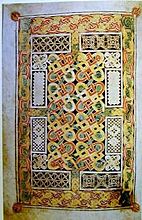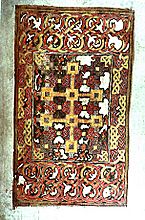Book of Durrow facts for kids
The Book of Durrow is a very old and special illuminated manuscript (a handwritten book with pictures) from around c. 700. It contains the Latin text of the four Gospels (stories about Jesus) from the Bible. It also has some Irish changes and other writings. The book is written in a style called Insular script and is beautifully decorated with Insular art. It features four full-page pictures of symbols for the Gospel writers, six special "carpet pages" (pages with only patterns), and many fancy first letters.
Scholars believe the Book of Durrow was probably made in Ireland, perhaps near Durrow Abbey in County Offaly. This abbey was started by a famous saint named Colum Cille (also known as Columba) in the 500s. Some people thought it might have come from Northumbria (a region in England), but Ireland is now the most likely place.
Records show the book was at Durrow Abbey by the year 916. This makes it one of the oldest surviving Irish manuscripts. The abbey was later damaged during the Norman invasion of Ireland. Over the centuries, the book has been repaired and rebound many times. Today, you can find it in the Library of Trinity College Dublin in Ireland.
Contents
What is the Book of Durrow Like?
The Book of Durrow is the oldest complete illuminated gospel book that we still have. It is even older than the famous Book of Kells by more than 100 years!
Contents and Size
The book includes the gospels of Matthew, Mark, Luke, and John. It also has other important texts at the beginning, like letters and summaries. The pages are about 24.5 by 14.5 centimeters in size. The book has 248 pages made from vellum (a type of parchment made from animal skin).
Amazing Artwork
The Book of Durrow is full of amazing artwork. It has:
- Six "carpet pages" – these pages are covered entirely in colorful patterns, like a fancy carpet.
- A full-page picture showing the symbols for all four Gospel writers.
- Four more full-page pictures, each showing a single symbol for one Gospel writer.
- Six pages with very large and decorated first letters.
- Many smaller decorated first letters throughout the text.
The book is written in a style called majuscule Insular script, which uses large, block-like letters. Some pages have been lost or damaged over time.
The Art Style
The artwork in the Book of Durrow shows how different art styles came together to create the unique "Insular style." One interesting thing is that the artist wasn't very good at drawing people. The symbol for Matthew, which is a man, has been called a "walking buckle" because of how it looks!
The animal designs in the book come from old Germanic art. The pictures of Jesus and the Gospel writers might be inspired by Pictish stones from Scotland. The patterns and carpet pages show a mix of styles. The swirling Celtic patterns and detailed designs found in later Irish books actually started here.
For example, the page shown on the left has animal patterns around the edges. These patterns are similar to designs found on Anglo-Saxon jewelry, like the treasures from Sutton Hoo. But the round design in the middle seems to come from Celtic art.
Evangelists' Symbols
The Book of Durrow uses a different set of symbols for the Gospel writers than what became common later.
- Matthew is shown with a man.
- Mark is shown with an eagle (usually it's a lion).
- Luke is shown with a calf (usually it's an ox).
- John is shown with a lion (usually it's an eagle).
Each Gospel usually starts with its symbol, followed by a carpet page, and then the first letter of the text. It seems like a carpet page for Matthew might be missing, or perhaps a different abstract page was meant to be his.
The first letter of each Gospel text is made very large and decorated. The letters that follow are often surrounded by dots. You can see how the art in the book is similar to metalwork, like the rectangular body of St. Matthew, which looks like a special type of decoration called millefiori.
The designs in the Book of Durrow have a sense of open space. There are areas of plain vellum that balance out the highly decorated parts. Besides animal patterns, you can also find spirals, triskeles (three-armed spirals), ribbon patterns, and circular knots in the carpet pages and borders.
Evangelists' Symbols Gallery
History of the Book
The book gets its name from Durrow Abbey in Ireland. This monastery was founded by Colum Cille (Saint Columba). Most scholars now agree that the book was made at Durrow, or at least in Ireland, around the year 700.
There's a note in the book that some people think says "Colum" wrote the book in twelve days. This probably relates to the belief that Saint Columba himself created it. While twelve days might be enough time to write one Gospel, it's not enough for four Gospels plus all the detailed artwork.
The Silver Shrine
We know for sure that Flann Sinna, who was a High King of Ireland from 877 to 916, ordered a silver cumdach (a special metal box or shrine) to hold the book. This shrine was the earliest known one of its kind. It was described in 1677 but then disappeared. These shrines were usually not easy to open, so once the book was inside, it was probably rarely taken out to be read.
The book was still at Durrow Abbey around the year 1100. The monastery itself was later destroyed after the Norman Invasion of Ireland. Its stones were even used to build a new castle.
A Healing Relic
Like other books believed to have been owned by saints, the Book of Durrow was seen as a holy object, a relic of Colum Cille. There's a story from 1627 that the person who owned the book used it to cure sick cattle. They would dip the book in water, and then give the water to the cows. Some pages in the book today show damage from being dipped in water, with a hole in the corner. This suggests that this part of the book might have been tied with a string and used for this purpose.
By 1547, when Durrow Abbey was closed, the book went into private hands. Later, between 1661 and 1682, it was given to the library at Trinity College Dublin, along with the Book of Kells.
Carpet Pages Gallery
The Book of Durrow has six beautiful carpet pages.



